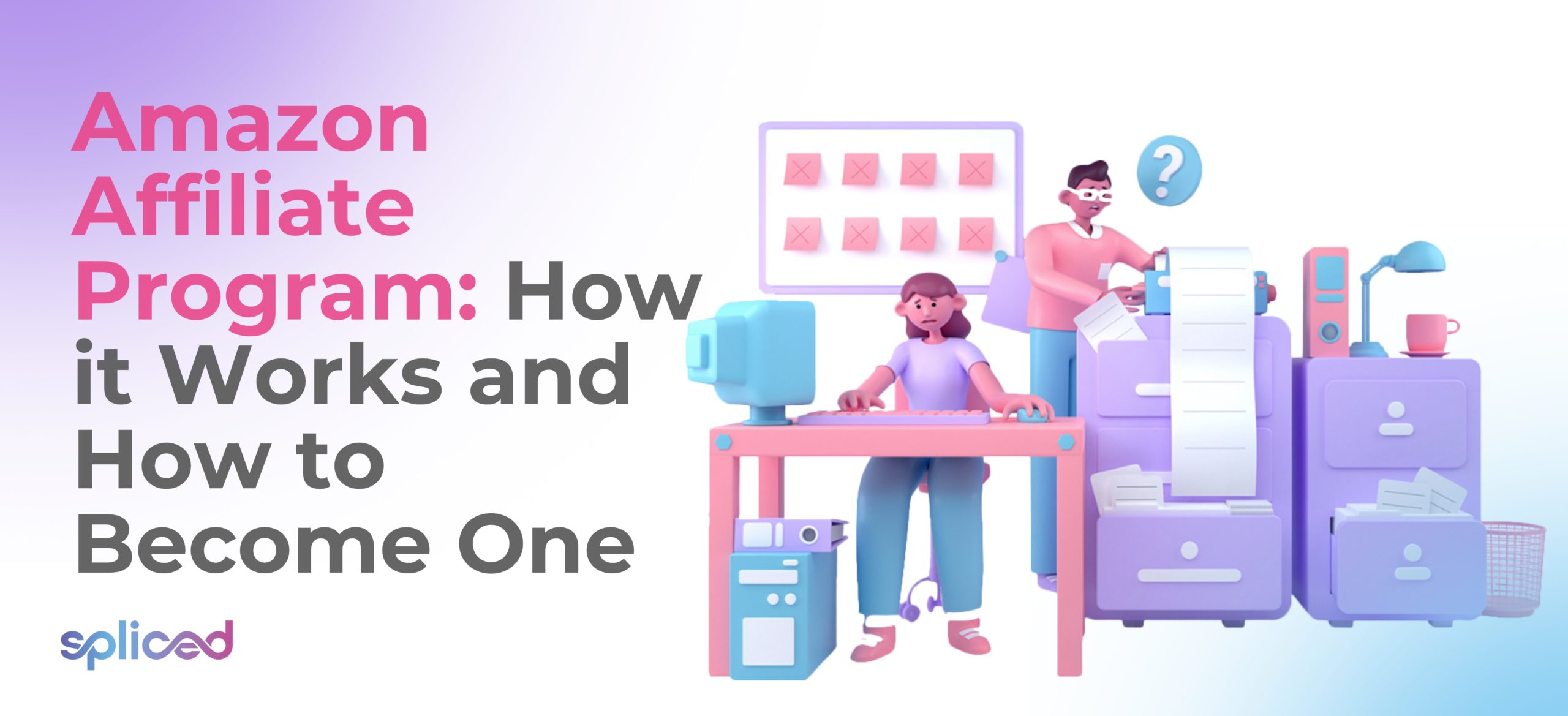The Amazon Affiliate Program is a promotional initiative launched by Amazon, a globally pioneering e-commerce organization. The Amazon Affiliate Program shelters individuals known as Amazon Associates with its major goal of enabling content developers, blog writers, and web page managers to monetize their online platforms through advertisements for Amazon products.
The program’s essence is focused on the advertisement and sales of Amazon goods. Affiliates select certain items from Amazon’s large catalog and market them using Amazon’s distinctive affiliate links. The affiliate receives a commission when a client accesses the links and acquires something from Amazon. The appealing feature of the program is that the affiliate obtains a commission even if the buyer refrains from buying the specific item but makes another transaction on Amazon within a certain period.
Anyone who has a digital platform is eligible to join the program whether they are a seasoned blogger, an influencer, a YouTube creator, or someone just starting with a passion for sharing product reviews. The Amazon Affiliate Program is a wonderful system for anyone wanting to supplement their income by promoting things they’re passionate about.
The process of enlisting as an Amazon Affiliate Program starts by navigating through the Amazon Associates homepage and selecting the ‘Join Now for Free’ option. Aspiring Amazon affiliates either register a new Amazon account or log into an existing one to link to their affiliate profile. The aspirant is requested to complete their profile, which includes information on their website, mobile apps, and any other digital platforms they intend to utilize to advertise Amazon products.
Submit precise payment and tax information to guarantee a smooth commission receipt after creating the profile. Wait for a few minutes for the registration to be approved. Users begin exploring Amazon’s extensive product catalog after the account is accepted, selecting things that are relevant to the target audience, and producing distinctive affiliate links for advertising.
The Amazon Affiliate Programme begins with sign-up and approval, in which the aspirant must apply on the Amazon Associates website and be accepted. Affiliates search Amazon’s massive product catalog for things to advertise on various networks.
Amazon gives affiliates an exclusive link that tracks traffic and sales for each product they opt to promote. Affiliates incorporate such one-of-a-kind links into their material.
The affiliate receives a commission when a user clicks on the affiliate link and purchases something from Amazon. Amazon tracks and consolidates all sales generated through affiliate connections. Amazon affiliates are paid via bank transfers, cheques, or Amazon gift cards, depending on their location and preferences. Amazon affiliates see extensive information on link clicks, revenue, and commission income via the Amazon Associates dashboard. It allows them to better identify what works and optimize their promotion methods.
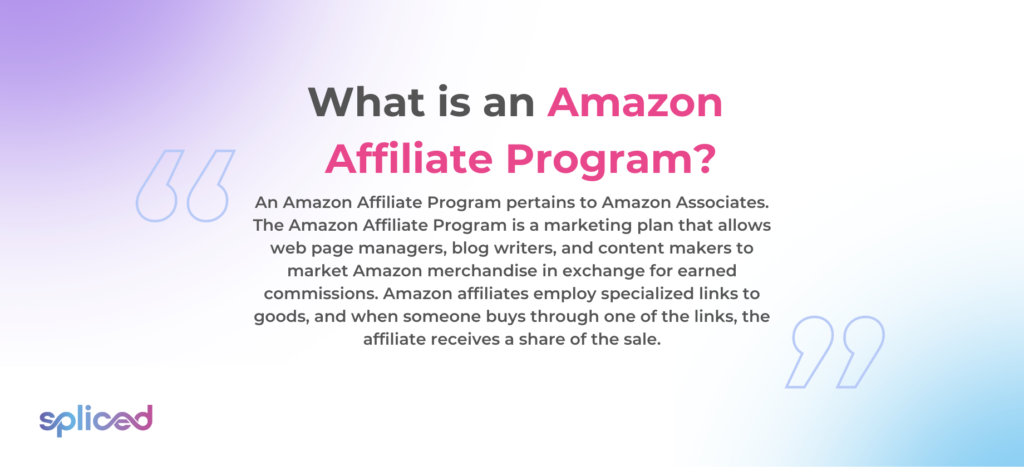
What is an Amazon Affiliate Program?
An Amazon Affiliate Program pertains to Amazon Associates. The Amazon Affiliate Program is a marketing plan that allows web page managers, blog writers, and content makers to market Amazon merchandise in exchange for earned commissions. Amazon affiliates employ specialized links to goods, and when someone buys through one of the links, the affiliate receives a share of the sale.
Amazon was not the first retailer to introduce an affiliate program and Affiliate marketing. Online referral became popular during the late 1990s. It was PC Flowers and Gifts, an online flower business started by William J. Tobin, that pioneered the first affiliate network for the web, which went live in 1989. The program was earning millions of dollars in annual sales by 1993 and had over 2,500 affiliates from all over the internet by 1995. Tobin was given a patent for affiliate marketing and tracking in the year 2000. Other companies, like Amazon, saw PC Flowers and Gifts’ success and chose to employ the same strategy.
Amazon’s affiliate network was one of the first of its kind, having launched in 1996. Amazon’s rise has been rapid for more than two decades. It has played an important part in the evolution of the e-commerce and online marketing industries throughout the years, setting the benchmark for affiliate marketing programs.
Amazon Affiliates now account for around 2.3% of all websites that employ advertising networks. Amazon Associates has grown in prominence as a result of Amazon’s extensive product offering and global presence. Amazon’s success has inspired many content providers, both experienced and inexperienced, to incorporate affiliate marketing into their revenue methods.
Affiliate commission rates vary greatly based on the product category, with some items providing a greater commission rate than others. The affiliate still earns a percentage of the sale even if a buyer does not purchase the linked item, provided that they purchase other things within 24 hours. The arrangement incentivizes Amazon affiliates to drive more traffic to Amazon’s website.

What is the purpose of the Amazon Affiliate Program?
The purpose of the Amazon Affiliate Program is to broaden Amazon’s marketing reach by using a large network of independent content makers, blog writers, and site administrators. Amazon capitalizes on varied and specific customer groups that they do not directly target through typical advertising efforts by paying such affiliates with a compensation structure.
The program provides affiliates with the option to monetize their material. They earn a fee by promoting things from Amazon’s large inventory, whether they run a blog, YouTube channel, podcast, or any other platform. The content author gets a share of the revenue generated when a viewer makes a purchase via the unique affiliate link.
Amazon has millions of products and programs available in which the associates use simple link-building tools to guide their audience. Amazon affiliates’ suggestions direct viewers towards the product and earn money from qualifying purchases and courses.
The Amazon Affiliate Program fosters a mutually beneficial partnership between Amazon and independent online marketers. Amazon profits from increased sales and product visibility, while affiliates profit by delivering product suggestions to their audience. The tactic increases revenue and improves Amazon’s status as the go-to e-commerce site.
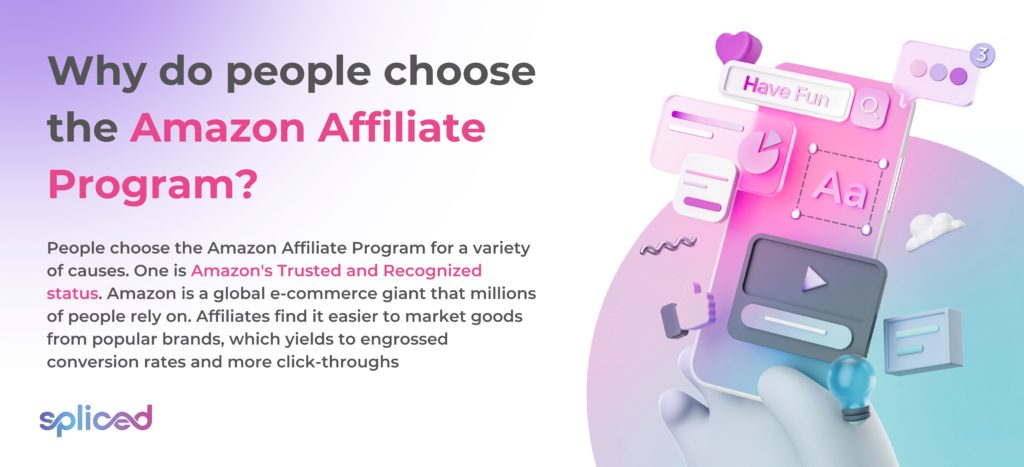
Why do people choose the Amazon Affiliate Program?
People choose the Amazon Affiliate Program for a variety of causes. One is Amazon’s Trusted and Recognized status. Amazon is a global e-commerce giant that millions of people rely on. Affiliates find it easier to market goods from popular brands, which yields to engrossed conversion rates and more click-throughs
Another reason people select the Amazon Affiliate Program is the large product range. Amazon affiliates locate items that precisely connect with their media and viewers by tapping into Amazon’s huge product inventory, regardless of how specialized their platform is. Amazon additionally delivers easy-to-use tools. The company provides affiliates with a variety of tools and statistics to help them track their success, refine their methods, and improve the revenue they generate.
Amazon’s Flexible Commission Structure tempts online advertisers to select their program. The notion of earning money on any goods purchased within 24 hours of hitting the affiliate link is intriguing for online marketers, though the compensation varies by product category.
Many people join the Amazon Affiliate Program in the hopes of earning passive money or monthly income. Other affiliates have turned affiliate marketing into a continuous monthly revenue stream while some are earning small amounts to complement their primary income. The earning potential is determined by the affiliate’s platform, number of viewers, participation, and methods used.
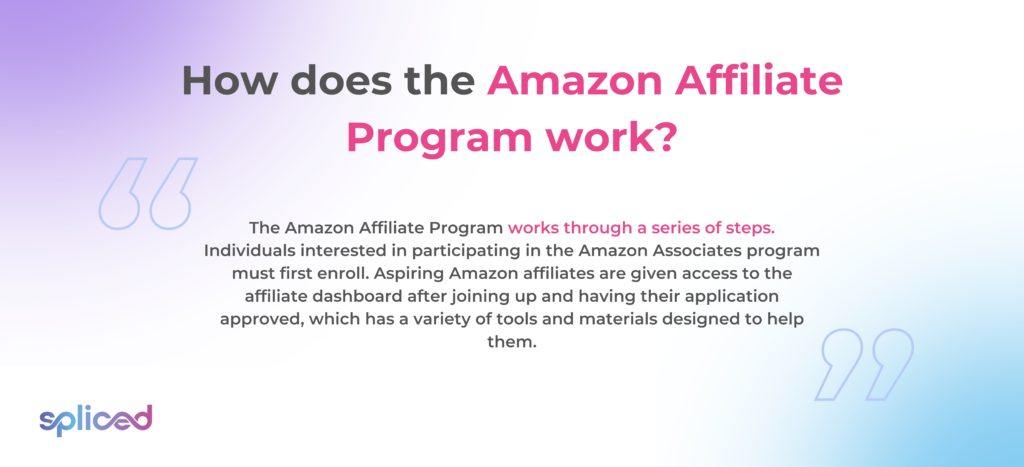
How does the Amazon Affiliate Program work?
The Amazon Affiliate Program works through a series of steps. Individuals interested in participating in the Amazon Associates program must first enroll. Aspiring Amazon affiliates are given access to the affiliate dashboard after joining up and having their application approved, which has a variety of tools and materials designed to help them. Affiliates subsequently search through Amazon’s massive product inventory, picking items they’re passionate about promoting, which is influenced by the content’s focus, the tastes of the people they’re targeting, or even current market trends.
Amazon provides a unique affiliate link for each product that an Amazon affiliate chooses to drive traffic to. The link serves as a tracking device to record the traffic and sales generated by a certain affiliate’s promotional efforts. Such distinctive linkages are effortlessly woven into their digital material. It is either included in a blog post, the description of a YouTube video, a tweet, or any other digital medium. The ultimate goal of affiliate marketing is to encourage the audience to click on the links presented to them, which transfers them to Amazon and potentially leads to a purchase.
The monetary aspect of the Amazon Affiliate Program is quite intriguing. The Amazon affiliate receives a commission once a user clicks on the affiliate’s link and purchases something on Amazon. Their commission is not strictly tied to the purchase of the linked goods but to every click the user makes. The affiliate receives a commission on such sales if the user purchases anything from Amazon within 24 hours of visiting the link. Note that commission rates vary depending on the product category.
Amazon’s performance tracking is one element answering “How does the Amazon affiliate program work?” The Amazon Associates dashboard acts as a hub for affiliates to assess their performance by giving crucial analytics such as link clicks, conversion rates, and earned profits. Such insights are critical in assisting affiliates in fine-tuning and maximizing their promotional strategy. The process is streamlined when it comes to getting their generated income. Affiliates withdraw their earnings once they have reached a certain minimum sum through direct bank transfers, cheques, or even Amazon gift cards, depending on their area and preferences.
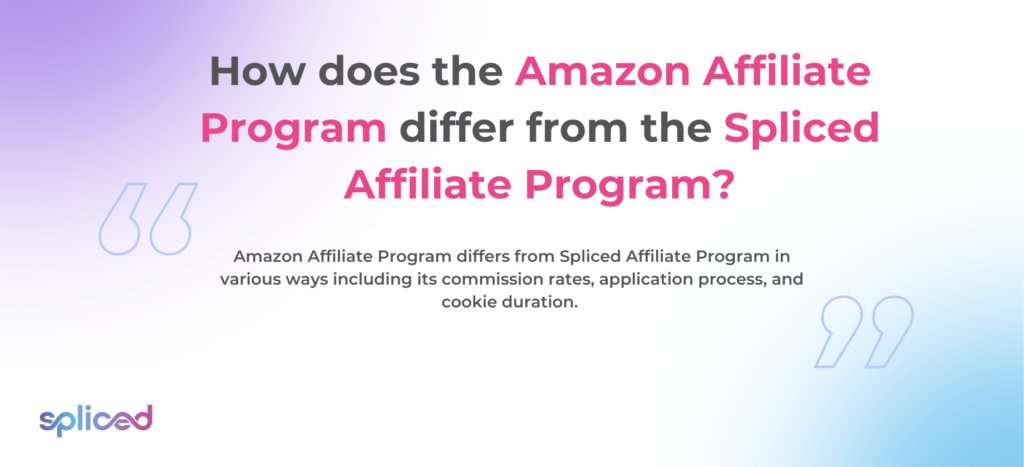
How does the Amazon Affiliate Program differ from the Spliced Affiliate Program?
Amazon Affiliate Program differs from Spliced Affiliate Program in various ways including its commission rates, application process, and cookie duration.
The Amazon Affiliate Program is one of the world’s most famous and well-known affiliate marketing programs. Individuals and website owners get commissions by recommending and referring to Amazon products on their websites or via other marketing channels. The affiliate receives a share of the earnings as a commission when a customer clicks on one of their affiliate links and purchases something from Amazon.
The Splice Affiliate Program compensates people and businesses who promote their products similar to the Amazon Affiliate Program. The program sends affiliates a commission for that sale whenever a client buys a product from Splice.
Affiliates with Splice earn $0.8 for every free trial and $11.20 for each subscription. Affiliates earn $0.8 per free trial and $11.20 for each subscription for each sale made using the unique affiliate link. The fee applies to all products, making it profitable income for people who actively promote Splice products to their target demographic. The Splice Affiliate Program offers a 60-day cookie duration, which surpasses the typical 30-day duration of other affiliate programs.
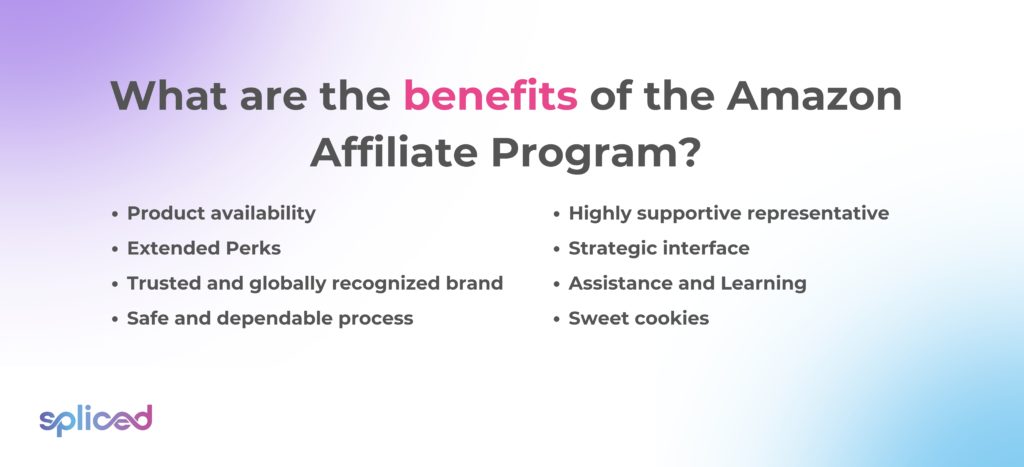
What are the benefits of the Amazon Affiliate Program?
The benefits of the Amazon Affiliate Program are listed below.
- Product availability: The broadness of the Amazon Affiliate Program’s product catalog is one of its most notable aspects. Amazon affiliates locate a product connected to nearly any niche or topic they cover, making it easy to match recommendations with content. Amazon’s wide selection ensures that there’s something for everyone whether pushing technology, books, fashion, or esoteric hobbies. The range of options allows for adaptability and flexibility in marketing techniques.
- Extended Perks: Aside from commissions, Amazon provides its affiliates with exclusive deals, tools, and information to help them enhance their marketing efforts. Seasonal sales and promotions provide opportunities for affiliates to increase their profits. The backend analytics of the program provide insights into user behavior, allowing affiliates to fine-tune their strategy. New features and benefits are offered regularly as the platform advances, ensuring that the program remains cutting-edge.
- Trusted and globally recognized brand: Promoting products from a well-known brand, such as Amazon, helps an affiliate’s viewers develop trust. Users are expected to click on a link and make a purchase when they recognize and trust the platform. Affiliates benefit from Amazon’s extensive global presence by utilizing such a trust to enhance conversions. The brand’s reputation makes it easier for potential buyers to persuade them.
- Safe and dependable process: Amazon employs stringent safety standards to ensure that transactions are secure and personal information is kept private. Affiliates and their viewers have confidence in the platform’s dependability, which reduces friction in the buying procedure. Amazon’s regular uptime and stable service make it a trustworthy partner for affiliates. The straightforward and fast commission payout method attests to its dependability.
- Highly supportive representative: Amazon provides affiliates with dedicated assistance and tools. Affiliates rapidly discover solutions to their questions by using comprehensive manuals, FAQs, or direct help channels. The program keeps its members up to date on modifications, new features, and best practices. Such a support system guarantees that Amazon affiliates, whether experienced or inexperienced, have the tools and assistance they require to succeed.
- Guaranteed sales: Amazon’s technology infrastructure is second to none. The user-friendly interface of the website, tailored recommendations, and quick checkout procedure improve user engagement. Conversion rates for affiliates increase because users find it simple and hassle-free to make orders. The platform’s ongoing advancements solidify its position as a leading player in e-commerce.
- Strategic interface: Amazon’s extensive product descriptions, feedback, and Q&A sections excel at presenting goods persuasively. Affiliates benefit from the structure because the platform itself helps to persuade potential buyers. Transparency in consumer feedback and extensive product information allow for more educated purchasing decisions. The all-inclusive strategy for selling assists affiliates in their marketing endeavors.
- Sweet cookies: “Cookies” are the tracking mechanisms that credit sales to an Amazon associate in affiliate marketing. The Amazon affiliate earns an amount if an end-user hits an affiliate link and makes a purchase during the next 24 hours because of Amazon’s 24-hour cookie. The period enables potential purchasers to ponder their options, which leads to the purchase of various products. Commissions for affiliates are still viable to increase, even if the buyer does not purchase the first connected product because of Amazon’s Sweet cookie method.
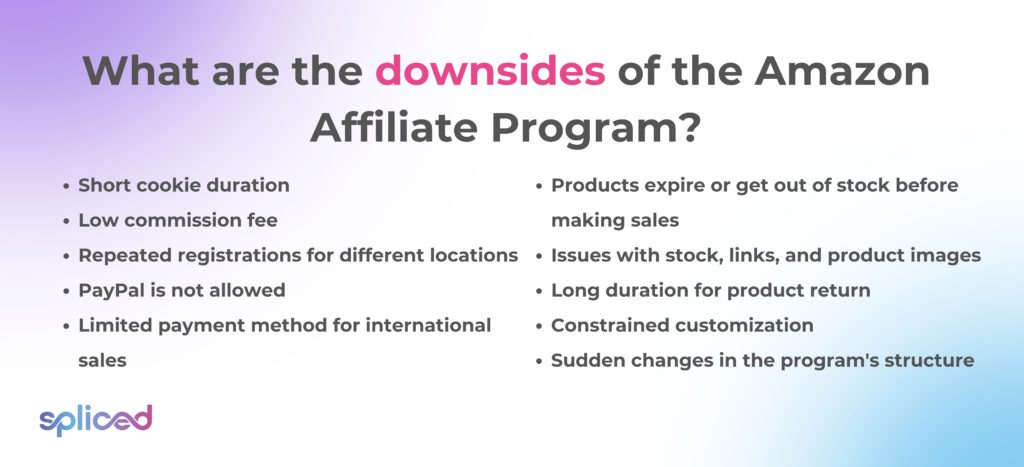
What are the downsides of the Amazon Affiliate Program?
The downsides of the Amazon Affiliate program are listed below.
- Short cookie duration: Amazon’s affiliate network uses a 24-hour tracking cookie, in which affiliates are given a day to receive a fee after a prospective buyer hits their link. It indicates that associates receive commissions on things purchased by the consumer within the first 24 hours. Other affiliate programs provide lengthier durations, often up to 30 days or more. The reduced timeframe is restrictive, particularly for the items that buyers contemplate before purchasing. Amazon affiliates lose out on prospective commissions if a purchase is made beyond 24 hours, as a result.
- Low commission fee: The commission rates in the Amazon Affiliate program range from 3% to 10% when compared to other affiliate programs. The proportion affiliates earn from each purchase varies according to the product classification. For instance, Amazon associates earn a 20% commission for having sold Amazon Game products, while just a 1% affiliate commission for selling supermarket items. Amazon associates require a large number of sales to achieve a substantial income. The prices are subject to shift as Amazon has been known to lower them in the past. Relying on Amazon as a key source of revenue is sometimes risky.
- Repeated registrations for different locations: Affiliates that want to target clients from different countries must sign up for each country’s Amazon Affiliate program separately. The Amazon Associates Program operates from 17 different sites throughout the world. America, Asia and Australia, Europe, India, and the Middle East, are its four key marketing regions. The process gets time-consuming and inconvenient because each location has its account administration. Multiple sign-ups make tracking sales and accepting payments more difficult. Amazon affiliates seeking a worldwide audience find the splintered strategy inconvenient as a result.
- PayPal is not allowed: Amazon does not accept PayPal for affiliate commission payments. Many individuals utilize PayPal because of its ease of use, swiftness and worldwide availability. Amazon affiliates have fewer options and deal with longer waiting periods and even higher fees with alternative payment methods because of PayPal’s unavailability on the Amazon platform. The dilemma is especially restrictive for overseas affiliates.
- Limited payment method for international sales: Amazon’s affiliate program includes barriers to how overseas affiliates get paid. Not all payment alternatives are available in every country, which is sometimes associated with additional requirements or higher charges. There are 52 countries whose currency is acknowledged by the Amazon Affiliates Program including the US, UK, Canada, and Europe. Affiliates who have joined Amazon Associate Programs in such locations are reimbursed through bank transfer in their local currency. Amazon Associates in Australia, South Africa, and Asia continue to be paid via cheque or Amazon gift card which requires extended waiting time. The restriction makes it difficult for affiliates outside of Amazon’s major markets to get their profits easily or promptly.
- Products expire or get out of stock before making sales: Affiliates advertise a product simply to discover that it is out of stock or unavailable on Amazon. Such an unprecedented scenario results in wasted work and loss of confidence from an audience expecting a product. Monitoring and updating affiliate links on a regular basis is vital, but it is an extra task that takes some effort and time.
- Issues with stock, links, and product images: Product links sometimes break or product photos change without warning. The issues result in inconsistencies between what is displayed on an affiliate’s website and what is accessible on Amazon. It creates confusion on the client’s part and diminishes the potentiality for sales by undermining faith in the affiliate’s suggestions.
- Long duration for product return: Amazon offers a robust return policy that allows buyers to return things within a certain time frame. Amazon has a 30-day return policy. An affiliate’s commission from a customer referred to Amazon is not given until the return period for a specific product is through. Some Amazon customers abuse Amazon’s return policy and intentionally purchase things simply to return them after a few moments of use. The affiliate’s commission is refunded if a customer returns goods. An affiliate’s profits fluctuate, and lose the commission from every sale, reducing its overall revenue stability.
- Constrained customization: Amazon supplies affiliates with a set of predefined applications, ads, and links. It limits affiliates’ creative license in better integrating or tailoring such capabilities for their individual market or web design needs. A lack of personalization choices on the affiliate’s site results in a less coherent or appealing presentation. Amazon affiliates feel constrained when it comes to maximizing customer interaction or the aesthetic integration of Amazon’s advertising resources.
- Sudden changes in the program’s structure: Amazon reserves the right to make abrupt changes to the structure or conditions of its affiliate program like any other large platform. Amazon affiliates are subject to Amazon’s decisions, as the company has the authority to modify the rate of commissions, the way payments are made, and the rules that affiliates are required to adhere to at any time without much notice. Amazon associates who rely on the program for income are at a disadvantage if they are not prepared for or aware of such changes ahead of time. Affiliates must be constantly watchful and adaptable because such changes are unanticipated, which adds to the strain of maintaining a consistent income source.

How to become an Amazon Affiliate?
To become an Amazon affiliate, a series of steps must be followed. The path begins with creating an online presence, which is accomplished by developing a website or blog to act as the primary platform used to advertise Amazon items. Navigate to the Amazon Associates homepage once the digital platform is operational. Locate the ‘Sign Up’ button on the homepage, to start the formal affiliation procedure.
Applicants to the program are required to provide their account information upon selecting the option, ensuring that any commissions and correspondence are properly directed. Amazon the applicant’s information about the website or blog they have created once their account details are confirmed. Entering the webpage address allows Amazon to examine and comprehend the platform where their products are advertised.
The method digs deeper into personalization. Amazon encourages affiliates to enter the desired shop ID, which corresponds to the name or theme of the website, adding a personal touch to one’s affiliate ventures. Amazon looks for more than just surface details as they want to comprehend the dynamics of the affiliates’ platform. The next phase requires applicants to explain how they plan to attract traffic to their site. It includes outlining their marketing and content strategy, SEO tactics, and other methods for attracting and retaining users.
Paying attention to the logistics is critical. Aspiring affiliates must decide on how they collect their hard-earned commissions. The platform prompts the affiliates to select the payment method of their choice, making future transactions run smoothly. Applicants to the Amazon Affiliates Program move on to generating Amazon Affiliate links after they have completed all of the requirements. Such unique web addresses are the tools affiliates use to advertise products, monitor viewers’ purchases, and gain commission. The affiliate links make the applicants ready to begin their Amazon affiliate journey.
Aspiring Amazon Affiliates register for the Amazon Associates program in less than an hour, given that all of the essential information is available. The approval procedure, however, differs. Some aspirants have to wait 24-48 hours for Amazon to consider their application while others receive fast approval. The evaluation takes up to 5 days in some circumstances especially if a further inspection is necessary. An Amazon Affiliate starts marketing products and earning commissions right away, once the registration is approved. Aspiring Amazon affiliates need to adhere to a structured approach to achieve successful registration and subsequent collaboration with the Amazon platform.
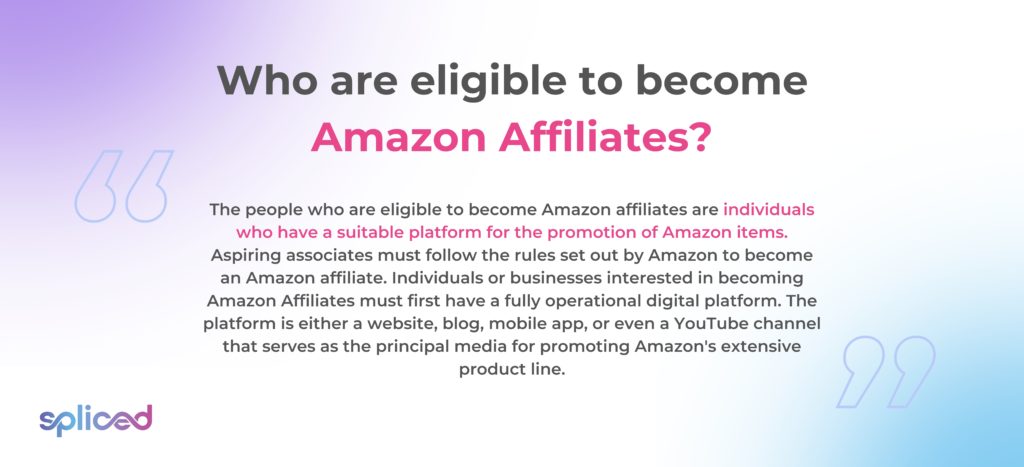
Who are eligible to become Amazon Affiliates?
The people who are eligible to become Amazon affiliates are individuals who have a suitable platform for the promotion of Amazon items. Aspiring associates must follow the rules set out by Amazon to become an Amazon affiliate.
Individuals or businesses interested in becoming Amazon Affiliates must first have a fully operational digital platform. The platform is either a website, blog, mobile app, or even a YouTube channel that serves as the principal media for promoting Amazon’s extensive product line. Candidates who opt to promote Amazon goods on online web pages must possess their own website. The site needs to display a minimum of ten original blog articles, the most recent of which must have been posted within the last 60 days. Websites must be open to the public and free of closed groups or paywalls.
People with mobile applications that function as website versions do qualify for the Amazon Associates program, providing another outlet for digital platforms. The software must meet certain criteria to be considered, including its free availability in major app stores, such as Google Play, Apple, or Amazon. Amazon prioritizes originality above availability which indicates that the app must offer distinctive, original material that stands out among other mobile apps. The style and functionality of the app must stay distinct from Amazon’s own shopping app while drawing inspiration from a variety of sources. It ensures a clear distinction between Amazon’s marketing app and the affiliate’s.
Social media influencers are eligible to become Amazon affiliates by promoting products on their social platforms. Influencers must have an active, public business account on a network to be eligible, such as Facebook, Instagram, Twitter, YouTube, TikTok, or Twitch.tv. They must have a large following, active participation, and at least 500 organic followers. Participation on Facebook and Instagram requires a business account. Remember to verify local restrictions as Amazon’s eligibility conditions vary by area.
The credibility of the platform managed by the candidates is another important factor in the choosing process. Amazon places a premium on sites that continually provide great material to their viewers. Evidence of high traffic or significant audience interaction becomes an essential element because it convinces Amazon of a prospective increase in revenue.
Every aspiring affiliate must strictly follow the Amazon Affiliates Program Operating Agreement. The agreement defines acceptable tactics and dangers to watch out for when recommending Amazon goods. It carefully promotes strategies and content validity, with the goal of maintaining a trustworthy and open affiliate environment.
The Amazon affiliate program requirements are based on maintaining a trustworthy platform, creating interesting material, and carefully complying with Amazon’s standards and guidelines.
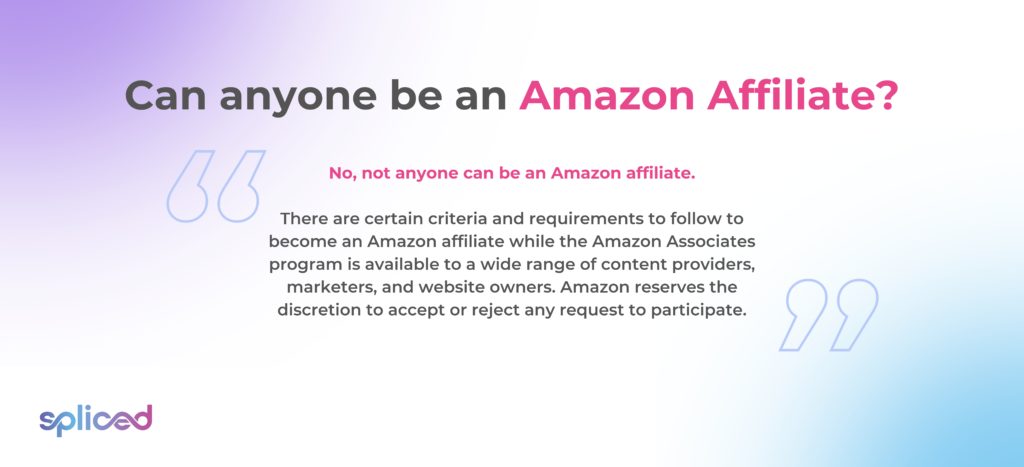
Can anyone be an Amazon Affiliate?
No, not anyone can be an Amazon affiliate. There are certain criteria and requirements to follow to become an Amazon affiliate while the Amazon Associates program is available to a wide range of content providers, marketers, and website owners. Amazon reserves the discretion to accept or reject any request to participate.
Candidates must first have an active digital platform where they aim to market Amazon products, such as a web page, blog, mobile application, or even specific social media accounts. The platform must provide high-quality material, be updated regularly, and have some amount of audience interaction or traffic. The Amazon Associates Program Operating Agreement establishes explicit guidelines for permitted methods of product promotion. Affiliates must conform to the contents of the agreement and avoid engaging in deceptive tactics, making false claims, or violating any of the terms specified.
Amazon keeps a list of content and platforms that are judged unsuitable for affiliation. Any website or forum found to be promoting themes of violence, prejudice, or other illegal actions is automatically disqualified. Amazon’s global reach necessitates that affiliates coordinate their efforts geographically. Joining the Amazon Associates program that meets the criteria for the area of the core audience is critical, as not all parts of the country have specific Amazon Affiliate programs.
Various requirements and essential guidelines are essential to becoming an Amazon affiliate, although the opportunity is open to many. It is to ensure the program’s integrity and conformity with Amazon’s goals and principles.
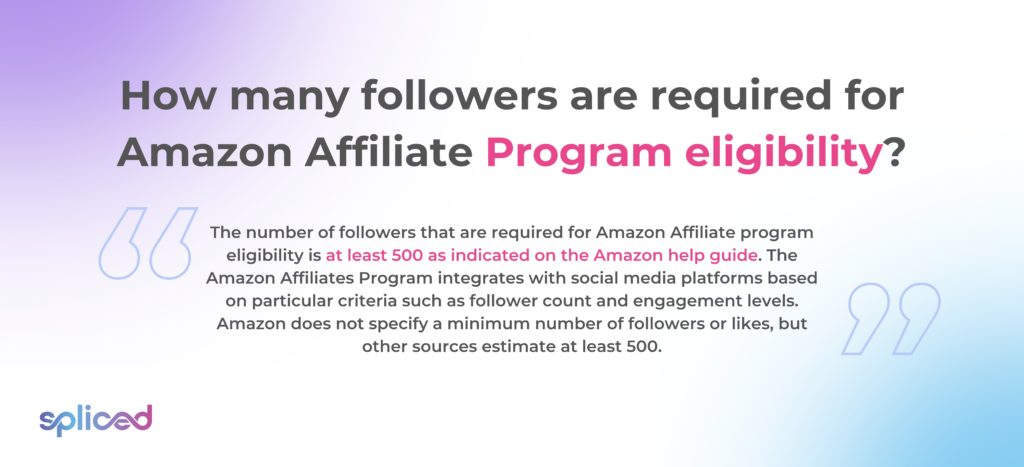
How many followers are required for Amazon Affiliate Program eligibility?
The number of followers that are required for Amazon Affiliate program eligibility is at least 500 as indicated on the Amazon help guide. The Amazon Affiliates Program integrates with social media platforms based on particular criteria such as follower count and engagement levels. Amazon does not specify a minimum number of followers or likes, but other sources estimate at least 500. The 500 organic followers criterion is exclusive to networks like Instagram, TikTok, Facebook, Twitter, Twitch.tv, and YouTube. It is expected to rise depending on the specifics of the social media network in question.
Amazon places a high value on a website’s engagement among its users beyond just numbers. The company requires candidates to maintain constant activity and relevant connections on their particular sites to be considered qualified.
Acceptance into the program is not entirely determined by the number of followers. The engagement rate, content quality, and audience trust are other critical factors to consider. Amazon’s criteria are subject to change and differ depending on area or platform details. Consult Amazon’s official documentation or support to receive the most recent and detailed requirements.

Can one be both an Amazon Affiliate and an Amazon Influencer?
Yes, one can be both an Amazon Affiliate and an Amazon influencer. Amazon Affiliate and Amazon Influencer are two unique Amazon programs, with unique sets of capabilities and rewards.
Amazon Affiliates, known as Associates, are involved in a more typical affiliate marketing platform. Commissions are earned by marketing and endorsing specific Amazon merchandise on their web pages, blogs, or other digital outlets. The emphasis lies on content-rich platforms that combine marketing items, feedback, and buying suggestions efficiently.
The Amazon Influencer Program, on the other hand, is designed for social media stars. Amazon launched the Amazon Influencer Program to connect with the online celebrities’ community, acknowledging the importance and global reach of social media individuals. Qualified influencers manage their own Amazon storefront where they showcase item endorsements based on their preferred product scope.
Amazon influencers are authorized to convey the storefront web address with their social media following. Shopping for the influencer’s recommendations gets easy for their followers as a result. Amazon affiliates get to manage a customizable storefront by becoming an Amazon endorser, where they endorse more goods and connect them to the Amazon store.
Amazon Associates and Amazon celebrities utilize the same core idea of marketing Amazon goods and obtaining rewards on revenues. The manner and platform of advertising, however, differ between such Amazon programs. It is feasible to become a member of both systems, with the Associate’s program employing a content-rich web page and the Amazon Influencer
program leveraging a strong social media exposure. It enables an individual to maximize potential reach and monetization opportunities across numerous channels.
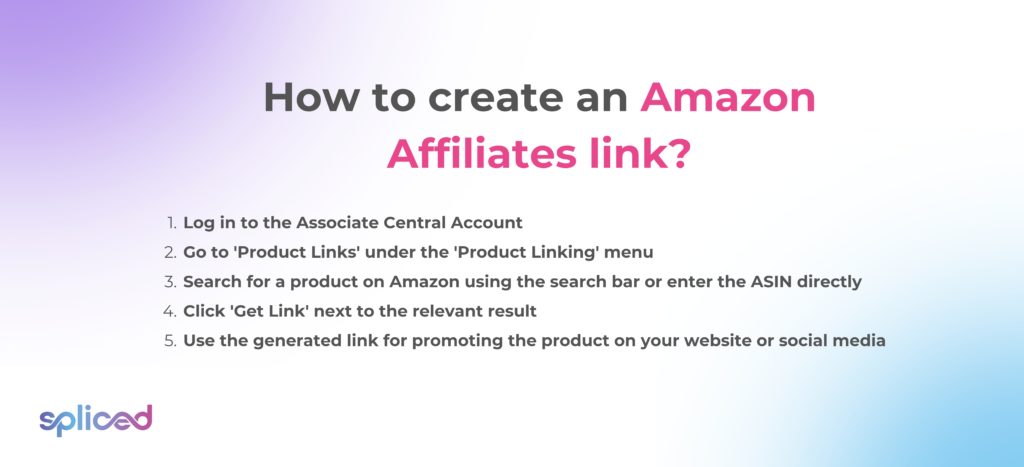
How to create an Amazon Affiliates link?
To create an Amazon Affiliate link, the following steps must be performed.
1. Log in to the Associate Central Account. Creating an Amazon affiliate link starts by logging into one’s Associate Central Account, which is Amazon’s dashboard for all of its associates. It is the initial step on how to get an Amazon affiliate link. The centralized site is where associates check their revenues, gain performance data, and find various methods for product promotion.
2. Go to ‘Product Links’ under the ‘Product Linking’ menu. Go to the ‘Product Linking’ option once logged in. The option contains a detailed interface designed to assist affiliates in finding and marketing each Amazon item. An option labelled ‘Product Links’ within the menu is discovered afterwards. Product links are tailored to look for and connect to specific goods on Amazon.
3. Search for a product on Amazon using the search bar or enter the ASIN directly. Use the given search bar to enter keywords relevant to the products being marketed. Entering the product’s ASIN (Amazon Standard Identification Number) is done alternatively.
4. Click ‘Get Link’ next to the relevant result. A selection of products that fit the criteria emerges following one’s search. Access the ‘Get Link’ button beside the merchandise after finding them. The action establishes a one-of-a-kind affiliate link associated with the account.
5. Use the generated link for promoting the product on your website or social media. Amazon affiliates integrate the specialized link into their marketing channels once it is obtained. The link tracks any transactions completed, crediting the commission to one’s affiliate account, whether embedded within a blog post, shared on social media, or included in an email newsletter.
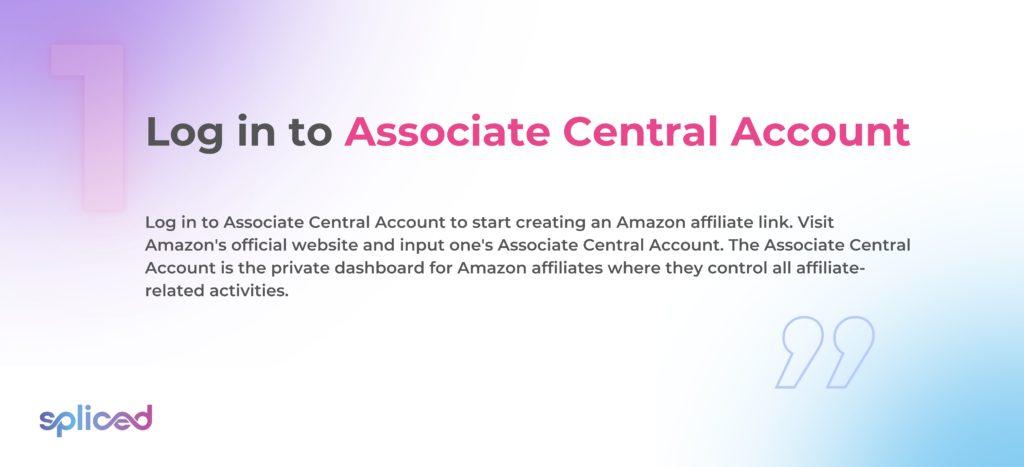
1. Log in to Associate Central Account
Log in to Associate Central Account to start creating an Amazon affiliate link. Visit Amazon’s official website and input one’s Associate Central Account. The Associate Central Account is the private dashboard for Amazon affiliates where they control all affiliate-related activities.
Affiliates who don’t have an account must first join the Amazon Associates program. They must log in with the assigned credentials once enrolled in the program. Amazon affiliates are presented with a variety of tools, reports, and options geared particularly for them, after successfully logging in. The dashboard serves as the beginning point for creating one’s distinctive product affiliate links.
Logging into the Associate Central Account guarantees that the link text is produced in association with the product being marketed using one’s account.
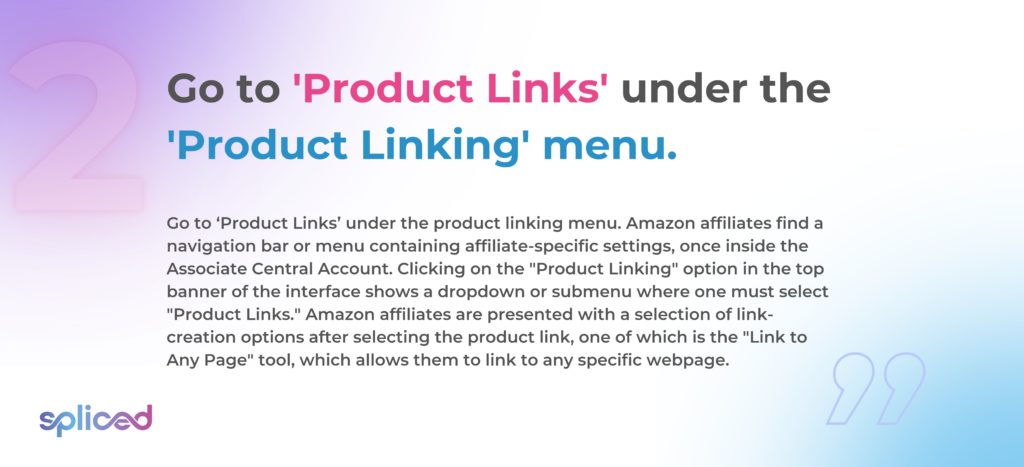
2. Go to ‘Product Links’ under the ‘Product Linking’ menu.
Go to ‘Product Links’ under the product linking menu. Amazon affiliates find a navigation bar or menu containing affiliate-specific settings, once inside the Associate Central Account. Clicking on the “Product Linking” option in the top banner of the interface shows a dropdown or submenu where one must select “Product Links.” Amazon affiliates are presented with a selection of link-creation options after selecting the product link, one of which is the “Link to Any Page” tool, which allows them to link to any specific webpage.
The section is intended to assist affiliates in searching for Amazon products and creating unique affiliate links for them. They locate and select products that correspond with their promotional content by inputting keywords or particular product characteristics, ensuring they deliver appropriate suggestions to the target market.

3. Search for a product on Amazon using the search bar or enter the ASIN directly.
Search for a product on Amazon using the search bar or enter the ASIN directly. A search box for locating specific products on Amazon’s massive platform is featured within the ‘Product Links’ area. Type in descriptive keywords or the name of the product to promote. A list of suitable goods that correspond to the keyed-in texts is displayed.
Consider utilizing the ASIN (Amazon Standard Identification Number) for greater precision and to ensure the search is linked to the exact product variant or edition looked for. The ASIN is a unique identification provided for each Amazon item. Amazon affiliates get rid of general search outcomes and focus on the precise item to promote by explicitly entering the product’s ASIN into the search bar. It assures the authenticity and relevancy of the suggestions that affiliates make. The careful search strategy optimizes affiliate experience by streamlining the link production process.

4. Click ‘Get Link’ next to the relevant result.
Click ‘Get Link’ next to the relevant result. A list of products matching the provided criteria is displayed following a product search using keywords or the ASIN. Each item listing includes a ‘Get Link’ button or option which is an entry point for creating a unique affiliate link associated with one’s account. Click on the ‘Get Link’ button next to the chosen goods after finding the correct product.
Amazon’s system generates a unique URL that traces any further transactions made by viewers and guarantees that the necessary commission is credited to the affiliate’s profile. The link is critical for tracking one’s promotional efforts and receiving credit for any sales produced from helpful recommendations given.
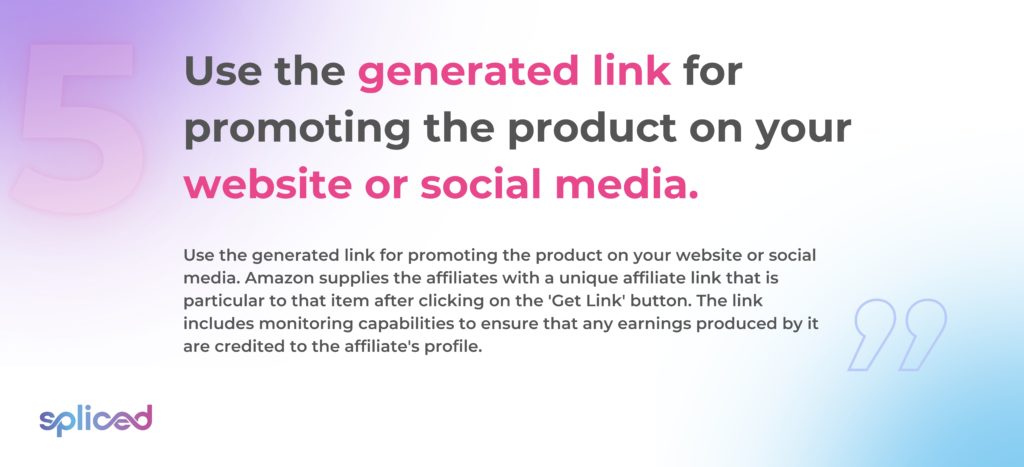
5. Use the generated link for promoting the product on your website or social media.
Use the generated link for promoting the product on your website or social media. Amazon supplies the affiliates with a unique affiliate link that is particular to that item after clicking on the ‘Get Link’ button. The link includes monitoring capabilities to ensure that any earnings produced by it are credited to the affiliate’s profile. Copy the link and paste it into one’s website, blog, or favorite social media network. Include the link whenever the content is written, whether it’s a suggestion piece, promotional material, or product review to ensure the target market has easy access to the goods.
The link functions as a bridge between one’s material and the product on Amazon, whether it’s adding the text to a social media post, inserting it into a YouTube video description, or hyperlinking it within a blog post. Make sure the link is relevant to the material and smoothly incorporated to preserve the audience’s confidence and facilitate their purchase experience. Remember that proper placement and context are necessary.
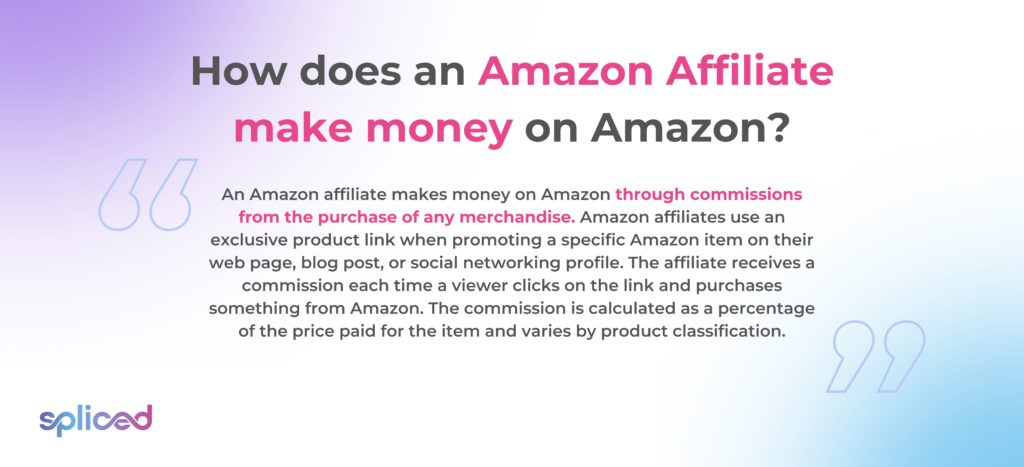
How does an Amazon Affiliate make money on Amazon?
An Amazon affiliate makes money on Amazon through commissions from the purchase of any merchandise. Amazon affiliates use an exclusive product link when promoting a specific Amazon item on their web page, blog post, or social networking profile. The affiliate receives a commission each time a viewer clicks on the link and purchases something from Amazon. The commission is calculated as a percentage of the price paid for the item and varies by product classification.
Amazon’s commission system demonstrates the monetization method. The commission schedule for Amazon Associates specifies the commission rates for each product category. For instance, computer peripherals have a smaller commission rate of 2.50% compared to premium beauty products and fashion apparel which have larger percentages at 10.00% per sale. Amazon games have the greatest commission income rate at 20.00%, while Grocery goods, Health and personal care have the lowest fixed commission rate at 1.00%.
Amazon conducts special campaigns or “bounties” in which affiliates earn extra funds by pushing specific services, such as Amazon Prime trials. Amazon affiliates receive a $3.00 bounty rate for every customer who successfully registers for the Amazon Prime Free Trial. They get a $25.00 bounty rate when a customer successfully registers for an Audible Premium Plus Annual Membership on Amazon.com.
The Amazon Affiliate program additionally employs a 24-hour consideration for sales, which others tag as “Sweet Cookie.” The 24-hour cookie indicates that any purchase the viewers make on Amazon from the link provided on the affiliate’s platform or any product similar to the one being endorsed during the next 24 hours brings the affiliate a reward to the Amazon affiliate promoting the item. The approach enhances the potential earnings for affiliates given the variety of products offered on Amazon.
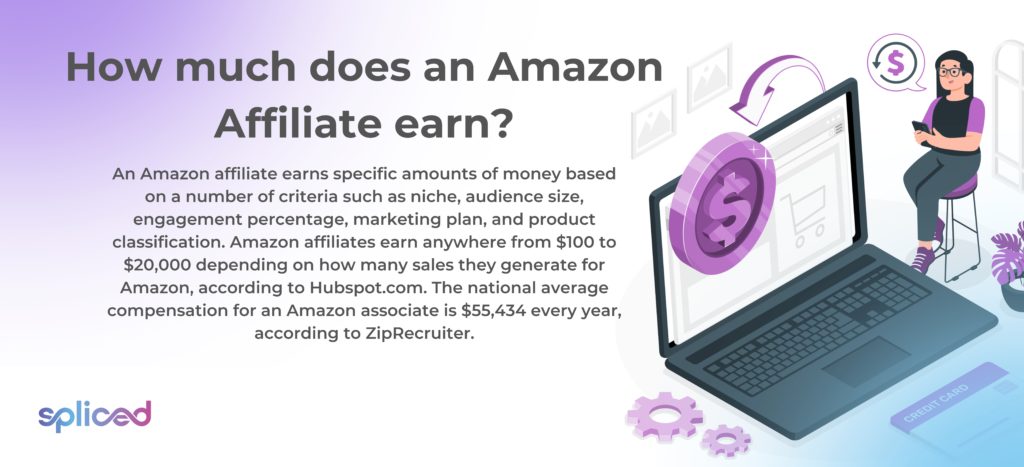
How much does an Amazon Affiliate earn?
An Amazon affiliate earns specific amounts of money based on a number of criteria such as niche, audience size, engagement percentage, marketing plan, and product classification. Amazon affiliates earn anywhere from $100 to $20,000 depending on how many sales they generate for Amazon, according to Hubspot.com. The national average compensation for an Amazon associate is $55,434 every year, according to ZipRecruiter. The wealthiest 1% earn between $111,500 and $121,000 per annum, while the bottom 10% receive between $16,500 and $26,000 on a yearly basis.
The potential earnings for an Amazon Affiliate are mainly influenced by the categories of products they promote which have fixed commission rates associated. The Amazon Games category offers affiliates the highest commission rate in the program at 20.00%, whereas, Amazon Fresh and Grocery Goods offers a meagre 1.00% commission. Other groups of Amazon products have commissions ranging from 3-4%. The cumulative effect of several sales increases one’s revenue while it appears insignificant at first. For instance, marketing a $100 toy earns an affiliate $3 for each successful transaction. The associate gets a $300 income from the single product if they sell 100 units in a month.
Traffic and conversion rates are another important aspect impacting earnings. An affiliate with a huge but disengaged audience earns more than one with a small but engaged audience. Conversion rates are heavily influenced by the quality of information, reliability, and relevancy of product suggestions. Amazon’s special promos or “bounties” have an impact on earnings as well. Affiliates are compensated for pushing and obtaining sign-ups for services such as Amazon Prime or Audible trials.
Extending one’s promotional reach increases prospective earnings and catering to niche markets such as premium beauty is even more rewarding. Remember that changes in Amazon’s compensation structure over the years have resulted in lower rates in specific categories, reducing affiliate profits. Keeping current commission rates in mind and modifying techniques helps to maximize prospective profits.
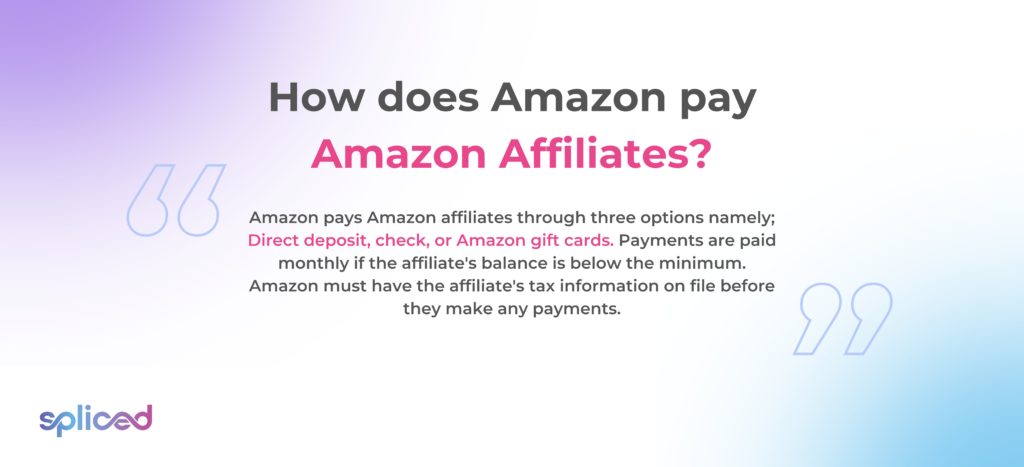
How does Amazon pay Amazon Affiliates?
Amazon pays Amazon affiliates through three options namely; Direct deposit, check, or Amazon gift cards. Payments are paid monthly if the affiliate’s balance is below the minimum. Amazon must have the affiliate’s tax information on file before they make any payments.
Direct Deposit is the most popular payment method for Amazon affiliates headquartered in the United States. Amazon deposits the funds directly into the affiliate’s bank account once the affiliate has earned a standard amount which is $10. The strategy guarantees speedy and electronic payment, reducing the need for any physical transactions. Amazon enables direct deposit to overseas affiliates who live in countries that support the Amazon Currency Converter for Sellers.
Amazon affiliates are permitted to receive their compensation through a physical check. The method, however, has a larger payment threshold of $100 at most and entails processing cost at $15. Payment through check takes longer because of postal times and some inherent delays.
Some affiliates elect to get their profits in the form of Amazon gift cards. Amazon sends a gift card to the affiliate’s email address when they achieve the minimum compensation criteria of $10, which they use to make Amazon purchases. The availability and specifications of such payment methods differ depending on the affiliate’s geographical area and the Amazon store with which they are affiliated.
Commissions are awarded after the order is shipped or delivered but the money is released roughly 60 days after the end of the month for which it is paid. For example, Amazon affiliates receive their payment by the end of March if they are paid by gift certificate and earned more than the $10 criteria in January.
Amazon affiliates must periodically check their selected payment method and ensure their contact and bank details are up to date to avoid payment problems. Affiliates must be aware that Amazon processes payments once a 60-day conversion window has passed, ensuring that all suggested sales are finalized and not refunded.
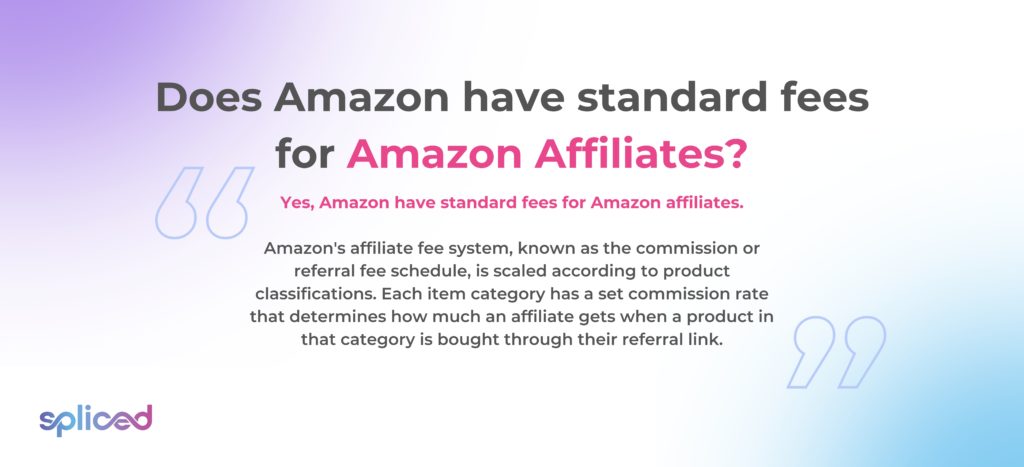
Does Amazon have standard fees for Amazon Affiliates?
Yes, Amazon have standard fees for Amazon affiliates. Amazon’s affiliate fee system, known as the commission or referral fee schedule, is scaled according to product classifications. Each item category has a set commission rate that determines how much an affiliate gets when a product in that category is bought through their referral link.
Amazon games, for example, have a different commission percentage of 20.00% than pet items, which have a commission ratio of 3.00%. Such rates are set by Amazon and differ depending on promotional campaigns or specific programs that Amazon is highlighting at a specific time.
Amazon has altered the compensation rates for several categories over the years, resulting in lower revenue potential for affiliates. The fees are “standard” in the sense that they apply consistently to all affiliates, but, they are still subject to change. Affiliates must be aware of special situations in which typical fees are not applicable. For example, special promotions or “bounties” provide varying rates. The affiliate’s compensation from a certain is removed alternatively if a buyer returns goods. Affiliates must always review the Amazon Associates Program Operating Agreement and the commission schedule frequently to stay up to date on current rates and terms.

How to earn more money as an Amazon Affiliate?
To earn more money as an Amazon Affiliate, consider the ways listed below.
- Develop a customized and workable niche: Tailoring the content to a specific audience is viable for Amazon affiliates by establishing a niche, which ensures uniqueness and higher engagement. Affiliates develop influence and credibility within that market exclusively. The specialization sets an Amazon affiliate against generic promoters and renders one’s suggestions more noticeable. Amazon associates obtain better conversion levels and bigger commission revenues by providing dedicated advice.
- Know when and where users scroll: Understanding the target audience’s online behaviors is critical. Publishing material during their most active internet hours or on channels they constantly use increases visibility. Amazon affiliates increase interaction and click-through rates by aligning their promotional efforts with the viewer’s browsing habits. Customizing content delivery to user behaviors increases the effectiveness of one’s affiliate marketing.
- Target better-paid categories or happenings: Amazon’s fee varies depending on the product classification. Amazon affiliates maximize revenue per sale by pushing products from groups with greater commission rates. Exploiting sales events such as Black Friday or Prime Day increases commissions because such events feature exclusive bargains and increase consumer attention. A targeted focus on profitable groups and activities increases the revenue of Amazon affiliates.
- Prepare gift guides and listicles on blogs: Gift recommendations and listicles are popular content types among readers. Affiliates bring both value and ease to readers looking for purchasing ideas by organizing lists of recommended products, such as “Top 5 Gifts for Travellers.” Such organized material ranks high in search engines, resulting in constant organic traffic. It caters to the individual demands of readers, increasing the rate of clicks on affiliate links.
- Refrain from gatekeeping: An Amazon affiliate must maintain transparency and accessibility although exclusivity appears enticing. Restricting or controlling material turns off potential customers and weakens confidence. An Amazon affiliate’s role is to enable and foster sales rather than to create obstacles. User experience must be prioritized at all times and make sure that the materials and suggestions are accessible to all.
- Produce demo videos using Reels and TikTok: Leveraging channels like TikTok and Instagram Reels provides a dynamic approach to market goods. Such short, compelling clips visually illustrate an item’s worth, making it easier for spectators to grasp its utility. The contagious nature of such networks leads to faster content distribution, affecting larger populations in shorter periods of time. An exquisite product demo generates significant traffic to Amazon product sites.
- Create intensive product vlogs on YouTube: YouTube enables detailed assessments of goods and presentations. Amazon affiliates provide viewers with detailed information, assessments, and usage recommendations by making extensive videos. Detailed presentations have a greater influence on purchasing decisions than shallow overviews. Remember that an informed viewer is more inclined to buy based on an in-depth suggestion.
- Get simple clicks with Pinterest: Pinterest is a visually appealing medium that is ideal for product advertising. Amazon affiliates drive large traffic to Amazon by generating appealing pins that highlight goods. Well-crafted posters readily lead to clicks and sales as Pinterest users look for product ideas and inspiration. Pinterest is a powerful ally for affiliates because of its consistent pinning and captivating images.
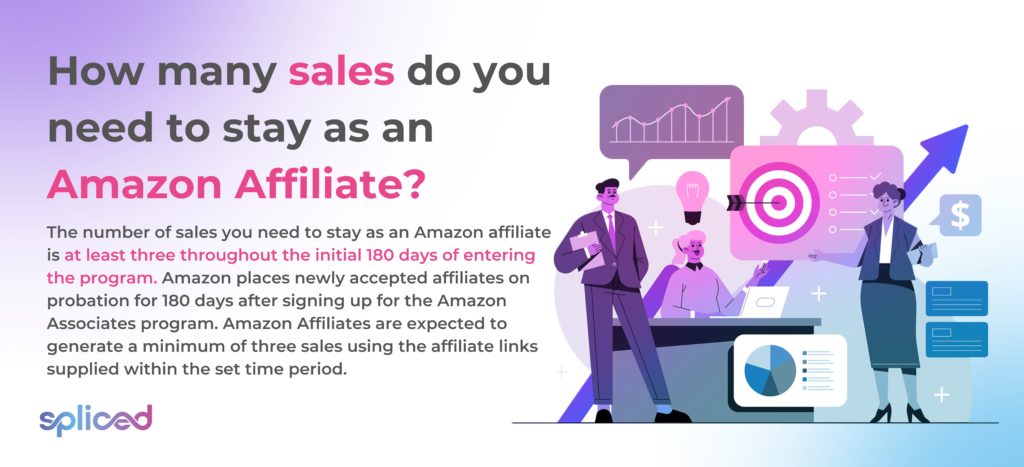
How many sales do you need to stay as an Amazon Affiliate?
The number of sales you need to stay as an Amazon affiliate is at least three throughout the initial 180 days of entering the program. Amazon places newly accepted affiliates on probation for 180 days after signing up for the Amazon Associates program. Amazon Affiliates are expected to generate a minimum of three sales using the affiliate links supplied within the set time period. Amazon has the discretion to ban the affiliate’s account if they fail to meet the requirement.
Terminated Amazon affiliates are permitted to reapply for the Amazon Associates program even if their account is closed. Amazon imposes the criteria to guarantee that affiliate participants are consistently advertising products and making revenues. The rule contributes to the program’s excellent performance and effectiveness by maintaining a team of committed and effective affiliates.
Awareness of Amazon’s demands is advantageous for all Amazon affiliates. It helps them organize their advertising efforts appropriately to reach the minimum sales criteria within the stipulated time frame.
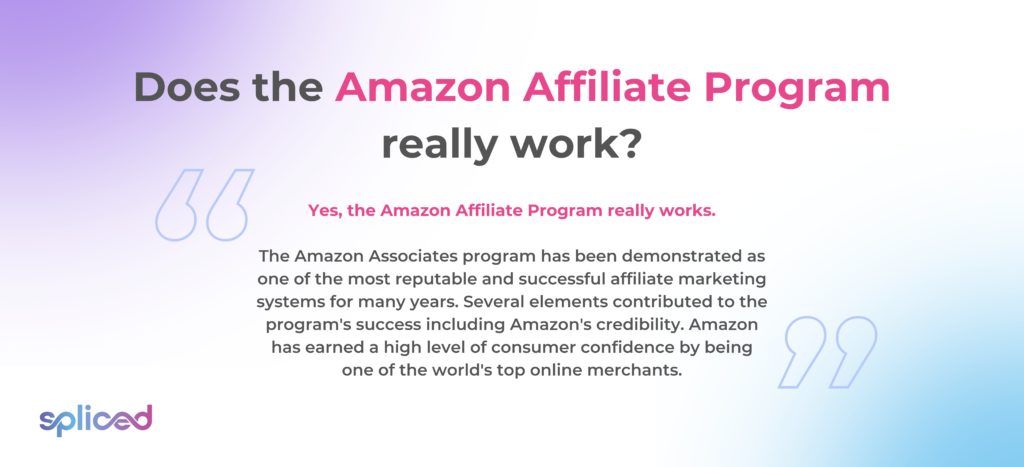
Does the Amazon Affiliate Program really work?
Yes, the Amazon Affiliate Program really works. The Amazon Associates program has been demonstrated as one of the most reputable and successful affiliate marketing systems for many years. Several elements contributed to the program’s success including Amazon’s credibility. Amazon has earned a high level of consumer confidence by being one of the world’s top online merchants. The credibility benefits affiliates by making it easier to advertise and market goods offered by the network.
The company’s extensive product line is another factor contributing to the program’s success. Affiliates select products that match their speciality because of Amazon’s large product catalogue, which assures accurate and enticing promotions for their viewers. The application has user-friendly tools which render the simple generation of connections, monitor sales, and clarify earnings.
The platform’s excellent conversion rates make it worthy of joining, although Amazon’s commissions are not usually the biggest when compared to other affiliate programs. Individuals who are recommended to the site are anticipated to complete a purchase because of Amazon’s extensive appeal and the trust it has built through the years.
Success in the Amazon Affiliate Program, like any other endeavour, still demands persistence, planning, and a grasp of the audience’s needs. Other affiliates are expected to find it difficult, especially if they lack a clear plan or a well-defined niche, while some have made significant money through the program. The program “works” the best when the affiliate invests effort in content production, audience engagement, and continual learning about the ever-changing e-commerce industry.
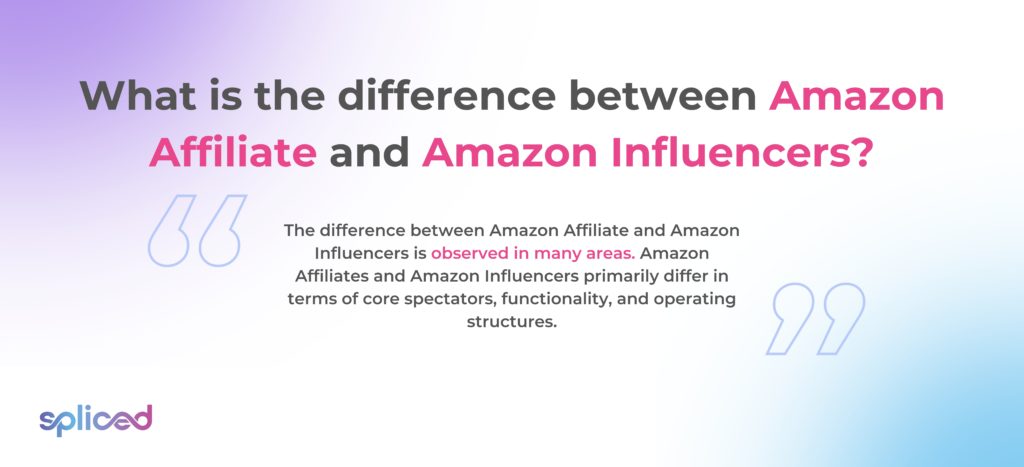
What is the difference between Amazon Affiliate and Amazon Influencers?
The difference between Amazon Affiliate and Amazon Influencers is observed in many areas. Amazon Affiliates and Amazon Influencers primarily differ in terms of core spectators, functionality, and operating structures.
The Amazon Affiliate program is a classic affiliate marketing network in which participants gain rewards through recommending and linking to Amazon’s goods on their various digital sites. The program has been around for a long time, allowing content providers to integrate product links within articles, blog posts, or web pages in exchange for a portion of sales generated by such links.
The Amazon Influencer Program is a recent program aimed toward social media personas who have large followings and interactions on online networking platforms like Instagram, YouTube, and Twitter. Eligible influencers receive a dedicated Amazon storefront where they curate and endorse products. The storefront offers followers a single location to shop suggested goods, reducing the hassle of browsing and the purchasing process.
Amazon Affiliates and Amazon influencers are schemes that both focus on product recommendations and rely on the promoter’s confidence and authority to boost revenues. Participants in both programs obtain a percentage of the products purchased through their referrals and rely on genuine and appealing material to induce sales. Amazon Affiliates and Influencers are equally obligated to openly declare their connection with Amazon. It includes telling their target audience that they gain sales commissions and assuring ethical marketing activities. The methodology and transparency of disclosure differ depending on the platform such as a blog vs. a social media, but both are required.
The key distinctions between the two are their primary operating platform and intended demographic. Amazon Influencers largely operate through social media platforms. The Influencer program highlights the influencer’s brand and power, appealing to a social media audience that engages with material more visually and engagingly. Amazon Affiliates operate through websites and blogs. The Affiliate program focuses on extensive material such as feedback, articles, and blog posts, which appeal to viewers looking for extensive details or suggestions.
Other important distinctions between affiliates and influencers include international traffic monetization, payment and commission structure, and account cancellation. International traffic is difficult for Amazon Affiliates since they need to sign up for separate Amazon Associate programs unique to each country. they need to employ tools or plugins that reroute users to the correct Amazon storefront. Amazon Influencers provide a more unified purchasing experience, potentially streamlining international customer involvement.
The actual rates and payment methods differ depending on the program although both Amazon Affiliates and Influencers earn commissions on sales. Influencers have access to special offers or campaigns that deviate from the usual affiliate commission structure. Amazon Affiliates and Influencers must follow Amazon’s rigorous requirements. Account termination results from violations such as deceptive promotional practices or failure to comply with disclosure rules. Failure to reach 3 sales within 180 days in the Amazon Affiliates program leads to termination, while account dormancy or not diligently endorsing products on the influencer’s storefront results in account cancellation.
The particular criteria for infractions differ across Amazon Affiliates and Amazon Influencers. Such regulations highlight the importance of members being well-versed in the terms and conditions of their programs.
